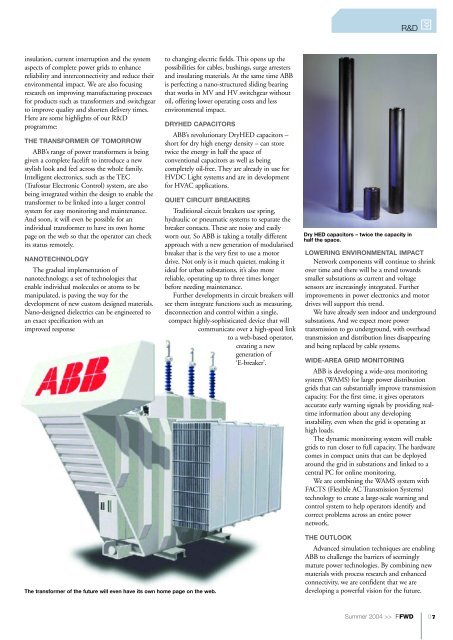7631 FFWD Sum04.qxd - ABB
7631 FFWD Sum04.qxd - ABB
7631 FFWD Sum04.qxd - ABB
Create successful ePaper yourself
Turn your PDF publications into a flip-book with our unique Google optimized e-Paper software.
R&Dinsulation, current interruption and the systemaspects of complete power grids to enhancereliability and interconnectivity and reduce theirenvironmental impact. We are also focusingresearch on improving manufacturing processesfor products such as transformers and switchgearto improve quality and shorten delivery times.Here are some highlights of our R&Dprogramme:THE TRANSFORMER OF TOMORROW<strong>ABB</strong>’s range of power transformers is beinggiven a complete facelift to introduce a newstylish look and feel across the whole family.Intelligent electronics, such as the TEC(Trafostar Electronic Control) system, are alsobeing integrated within the design to enable thetransformer to be linked into a larger controlsystem for easy monitoring and maintenance.And soon, it will even be possible for anindividual transformer to have its own homepage on the web so that the operator can checkits status remotely.NANOTECHNOLOGYThe gradual implementation ofnanotechnology, a set of technologies thatenable individual molecules or atoms to bemanipulated, is paving the way for thedevelopment of new custom designed materials.Nano-designed dielectrics can be engineered toan exact specification with animproved responseto changing electric fields. This opens up thepossibilities for cables, bushings, surge arrestersand insulating materials. At the same time <strong>ABB</strong>is perfecting a nano-structured sliding bearingthat works in MV and HV switchgear withoutoil, offering lower operating costs and lessenvironmental impact.DRYHED CAPACITORS<strong>ABB</strong>’s revolutionary DryHED capacitors –short for dry high energy density – can storetwice the energy in half the space ofconventional capacitors as well as beingcompletely oil-free. They are already in use forHVDC Light systems and are in developmentfor HVAC applications.QUIET CIRCUIT BREAKERSTraditional circuit breakers use spring,hydraulic or pneumatic systems to separate thebreaker contacts. These are noisy and easilyworn out. So <strong>ABB</strong> is taking a totally differentapproach with a new generation of modularisedbreaker that is the very first to use a motordrive. Not only is it much quieter, making itideal for urban substations, it’s also morereliable, operating up to three times longerbefore needing maintenance.Further developments in circuit breakers willsee them integrate functions such as measuring,disconnection and control within a single,compact highly-sophisticated device that willcommunicate over a high-speed linkto a web-based operator,creating a newgeneration of‘E-breaker’.Dry HED capacitors – twice the capacity inhalf the space.LOWERING ENVIRONMENTAL IMPACTNetwork components will continue to shrinkover time and there will be a trend towardssmaller substations as current and voltagesensors are increasingly integrated. Furtherimprovements in power electronics and motordrives will support this trend.We have already seen indoor and undergroundsubstations. And we expect more powertransmission to go underground, with overheadtransmission and distribution lines disappearingand being replaced by cable systems.WIDE-AREA GRID MONITORING<strong>ABB</strong> is developing a wide-area monitoringsystem (WAMS) for large power distributiongrids that can substantially improve transmissioncapacity. For the first time, it gives operatorsaccurate early warning signals by providing realtimeinformation about any developinginstability, even when the grid is operating athigh loads.The dynamic monitoring system will enablegrids to run closer to full capacity. The hardwarecomes in compact units that can be deployedaround the grid in substations and linked to acentral PC for online monitoring.We are combining the WAMS system withFACTS (Flexible AC Transmission Systems)technology to create a large-scale warning andcontrol system to help operators identify andcorrect problems across an entire powernetwork.The transformer of the future will even have its own home page on the web.THE OUTLOOKAdvanced simulation techniques are enabling<strong>ABB</strong> to challenge the barriers of seeminglymature power technologies. By combining newmaterials with process research and enhancedconnectivity, we are confident that we aredeveloping a powerful vision for the future.Summer 2004 >> <strong>FFWD</strong> 07
















